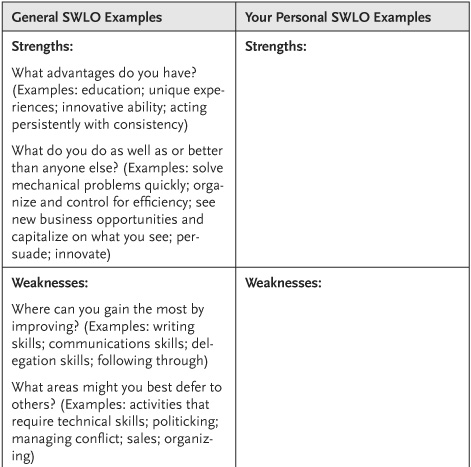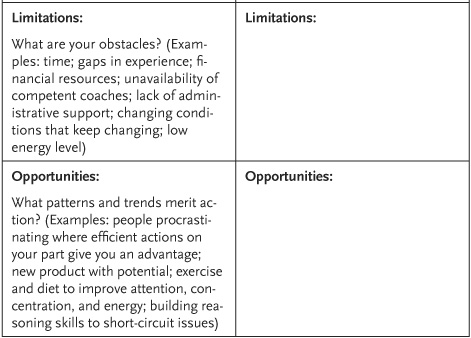End Procrastination Now! (22 page)
Read End Procrastination Now! Online
Authors: William D. Knaus

In this chapter, we'll look at procrastination in work settings. I'll start with why workplace procrastination takes extra work steps to curb. Then we'll move to
blame avoidance procrastination
. This silent procrastination trigger appears to be extensive. As procrastination can be a symptom of job dissatisfaction, you'll see how to align your preferred job functions with a job. I'll finish with a five-point management process to address procrastination.
It takes extra steps to address work procrastination, and this means additional work. However, this is not much different from taking extra steps to take corrective actions to rid you of a debilitating inhibition, a general sense of anxiety, or an eating habit that leads to your being overweight. Believing that procrastination can be whisked away by a “just-do-it” solution is likely to be as effective as quelling a lifetime of anxiety by telling yourself, “just be brave.”
If you want to overcome procrastination, it is usually wise to front-load your counter-procrastination work. Wishes and false promises to turn back a procrastination current support repeating a procrastination pattern.
Many of the methods given here apply to curbing procrastination as you learn to be a more effective you. Although ridding yourself of procrastination takes work, that is as it is. If you get out
of shape, getting back into shape is not something that happens overnight. That, too, is as it is. Let's continue.
If you tend to procrastinate persistently at work, is this a general pattern that you'd take with you anywhere you worked? If so, then you have an opportunity to work out your procrastination problem wherever you are working at the moment. On the other hand, if procrastination is a symptom of your being in the wrong job, it is a symptom worth heeding.
Sarah loved looking at the plaques and awards that she had won for excellence in sales. She had a habit of keeping on top of things and richly deserved her awards. She thought that her next logical step was a sales manager position. She applied for the position at her company when it opened, and she got the promotion. That dream soon turned into a nightmare.
The management job was different from what Sarah had thought it would be. It partially involved a skill set that she already possessed, and partially a skill set that was not her cup of tea.
Sarah found she was great at advising individual members of the sales force on how to improve their performance, and at personally serving several key accounts. However, she was slow at or avoided reviewing reports, setting goals, designing staff training programs, and overall coordination of the sales force to achieve performance and sales objectives. She was weak on planning when this involved multiple staff members. Also, organizational politics presented Sarah with many unexpected challenges. Her former sales manager had been a master at finessing such matters and had shielded Sarah and the other salespeople from corporate politics. She was unprepared for competitive issues between herself and the managers of manufacturing, marketing, and accounting, each of whom had a deserved reputation as a bully. She was challenged getting her sales force to
focus on issues, such as providing information on sales projections for their territories and completing sales reports.
Sarah was ambitious. A management job represented a step up in status and a higher salary. However, her new role brought to the surface multiple areas of difficulties that required her to function differently from the way she was prepared to function. Procrastination surfaced in every way, and Sarah eventually couldn't get out of the hole she dug for herself. Her procrastination was a signal that she was in the wrong job. She went back to sales. She dealt exclusively with key accounts. She returned to her old form of operating like an efficiency superstar because she was back operating in an area where she could influence the outcome. Once again, she created an excellent track record.
Ed did an excellent job as a chief of staff for a state senator. His career profile suggested that this was a viable career direction. He also had the temperament, interests, and skills to function effectively as an elected public official.
The senator decided against running for reelection. As a reward for his good services, the senator cleared the way for Ed to get a job managing a homeless shelter.
Once he was on the job, Ed did quite well in managing his relationships with local politicians. He enjoyed the exchanges and camaraderie. However, that was not his primary job function. Key managerial aspects of his job proved to be trouble spots.
Ed disliked dealing with union matters. He soon created contention between himself and union officials with his personnel policies and practices. He often violated the collective bargaining agreement and had a growing list of arbitrations to attend.
His deteriorating relationship with the union resulted in the union members following his instructions to the letter. This led to a slowdown, and the buses did not run on schedule. In a thin-skinned and defensive way, Ed sloughed off consumer complaints about the declining quality of services and maintenance. Lacking knowledge of the operation, he relied on his subordinates to manage the day-to-day
operation. Unfortunately, most of them had also gotten their jobs through political connections and suffered from limitations in management acumen. A series of unfavorable news articles were the kiss of death for his career as a manager of a municipal bus operation. At that point, his political friends figuratively threw him under the bus. However, this was the best thing that could have happened to Ed at the time. He reentered the world of politics.
What went wrong? Ed got in over his head in an area in which he lacked executive management skills. He ticked off a powerful union. Rather than study ways to fix problems, he defended the current practices. He didn't replace managers who demonstrated inadequate capacity to handle the day-to-day operations. He skirted ways to meet customer expectations about timely services by taking his eye off that matter. This job was not his cup of tea, and that partially explains his procrastination across the spectrum of his primary job responsibilities.
Remember that the first part of ending procrastination is to become self-aware. Think about your procrastination habits at work and what's really causing them. Is procrastination a symptom of a larger problem? Could it be caused by job dissatisfaction or by another issue?
END PROCRASTINATION NOW! TIP
WORKS Plan
w
hen starting a project, do the toughest or critical part first for effectiveness.
O
rganize your resources and order your activities for efficiency.
R
egulate your thoughts and actions to advance your work plan.
K
eep clear of needless distractions, such as procrastination diversions.
S
tay with your strengths as they apply to the process.
Take stock of where you are in your career, where you'd like to head, and what you need to do to improve your chances for achieving your career goals. Here are a few questions to start the process:
⢠Are you currently in the right job and at the right level for your experience and talent?
⢠What is your potential for assuming additional responsibilities, and at what level?
⢠Would you need to prepare yourself now for either lateral or hierarchical advancement?
⢠What barriers are likely to be in the way, such as procrastination?
Believing that you have work resources that you can rely upon increases job satisfaction. The bottom line is: you'll work productively where you align your talents and interests with a job and where you stretch to advance where you do best.
A strengths, weaknesses, limitations, and opportunities analysis (SWLO) is a strategic planning tool that organizations apply to position themselves to put their resources to the best use. You can use this method to focus your efforts on reducing procrastination by boosting your productive capabilities.
By visibly organizing information about your work resources, you'll find more opportunities to execute them. Using SWLO as a system to frame information about what you have going for you and what you can profitably avoid, you can sharpen your judgment about (1) whether you are on the right career track, (2) skills that you could transfer to a new job, and (3) strengths and talents that productively support organizational goals.
To complete the analysis, start with the three most important conditions for each area. Long lists invite procrastination. An example of such an analysis is given in
Table 7.1
.
TABLE 7.1


The weaknesses you identified in the SWLO analysis are potential procrastination hot-spot areas. You may have to deal with these matters regardless of the kind of work that you undertake. However, when you perform more of your preferred and fewer of your less-preferred work functions, you'll procrastinate less. Additionally, you can use SWLO to
⢠Identify areas that you can use to determine the closeness of fit between your strengths and your work.
⢠Sharpen your view about where you are likely to perform best and why.
⢠Identify or reinforce the value of the functions you perform that militate against procrastination.
⢠Identify work responsibilities to boost productivity when procrastination is not part of the picture.
Working in areas where your strengths apply lowers your risk of procrastinating, which can negatively affect your overall performance. Doing what comes easily, what you enjoy, and what you will work hard at is a formula for experiencing passion in your work, for generating successes, and for procrastinating less.
Each new instance of a hot procrastination process is likely to have both familiar and unique features. Addressing each new episode effectively typically takes tested strategies and innovative new ones. The five-phase process can be applied to advance this initiative.
Up to this point, you've seen how to apply psychological strategies to reduce procrastination and make performance gains by using the time you save when you don't procrastinate. Now we'll look at how to apply a management strategy that you can use to regulate your efforts to help solve procrastination problems and also prevent them.
In using the five-phase self-regulation approach, your key is to identify productive opportunities that are impeded by procrastination hot-spot thinking and diversionary actions. This is a framework for coordinating basic management methods to prevent procrastination and to produce higher-quality results. The steps are to (1) analyze a procrastination situation, (2) set a direction, (3) create an action plan, (4) execute the plan, and (5) evaluate the results.